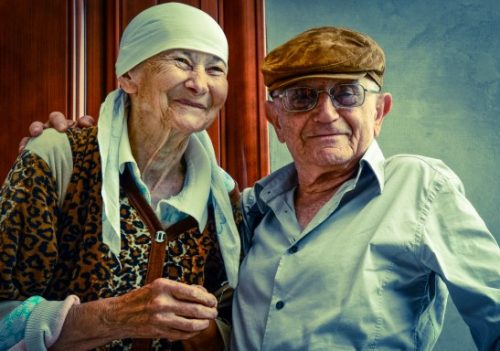Nash Holos: Shimon’s Returns
 Welcome to Ukrainian Jewish Heritage on Nash Holos Ukrainian Roots Radio. I’m Peter Bejger.
Welcome to Ukrainian Jewish Heritage on Nash Holos Ukrainian Roots Radio. I’m Peter Bejger.
It’s never too late to have a happy childhood.
An astonishing new film called Shimon’s Returns proves the point in a sometimes provocative but always heart-warming manner.
The documentary, directed by Slawomir Grunberg and Katka Reszke, tells the story of the now-retired Israeli history professor Shimon Redlich.
In the film, Shimon takes some of his Israeli cousins on a trip. A trip back into his childhood. A trip back to the villages, towns, and cities of western Ukraine and Poland. A Holocaust survivor, Shimon shows the hiding places and the people who saved not only his remarkable childhood, but also his life.
“There is no question that my happy childhood years had a strong effect on my whole outlook,” says Shimon in the film’s narration. “These years make me strong and feel good until this very day.”
Shimon was born into a middle-class family in Lviv before the war. And for the first ten years of his life he lived in the town of Berezhany, about ninety kilometers from Lviv.
Most of Shimon’s family did not survive the war. His father’s remains are located somewhere in a mass grave, whose uncertain location in a grassy field Shimon visits in a heart-rending scene in the film.
But Shimon survives the first period of great danger hidden in an attic in Berezhany’s ghetto. “I was able to see the church through a small hole,” he narrates. “I remember looking out into the marketplace very nearby. And I saw people walking but I was removed from them by light years. I was living in a completely different world.”
A Polish father and his son, Stanislaw and Karol Cadogni, supplied at great risk packets of food to the attic. But when the danger became too great, it was time to move.
Shimon was sent to “paradise,” which is what Rai, the name of a nearby village, means in Ukrainian. And there he found refuge with a Ukrainian peasant woman named Tanka Kontsevych and her two small children. The Nazis had taken away Tanka’s husband for slave labor in Germany.
Tanka’s nine-year-old daughter Ania proved to be especially crucial to Shimon’s story. And in the film the now elderly Ania recounts the harrowing story. One day two German soldiers suddenly showed up. Ania’s mother was not around and the soldiers were about to stumble into Shimon’s hiding place. But Ania proved to be very bold and clever in the face of dire circumstances. In light of her bravery, Little Ania received recognition as a Righteous Gentile from Israel’s Yad Vashem, despite the usual rules reserving this recognition to those twelve years old or older.
Shimon underlines that the rescue of Jews by Ukrainians is a very important issue. Shimon has been working for years to have Israel’s Yad Vashem recognize Ukrainian Greek-Catholic Church Metropolitan Andrei Sheptytsky as a Righteous Gentile. One segment of the film features an interview with the frail and elderly nun Sister Chryzantia, one of the oldest surviving witnesses of how Sheptytsky saved nearly 150 Jews through a network of monasteries and churches.
For the charismatic and fearless Shimon, daily life should embrace laughter and good cheer. He approaches total strangers on the streets of Ukraine and Poland for conversation and even impromptu dancing. And this approach provides several striking scenes, including one where he talks to a group of men wearing German SS uniforms. The encounter provides an unexpected insight into how the demons of history are viewed by not only survivors, but also by a contemporary generation.
“I always try to find the oldest person who lives there,” recalls Shimon. “Someone who perhaps remembers something. From time to time, I like to stop people on the street and start a conversation. To me it’s not enough at all to check archival documents and read newspapers. A very important part in research and writing history is the human touch. In other words, meeting with real people who went through these times and events.”
After his dramatic Ukrainian childhood, Shimon spent several years in Poland. He then left for a new life in Israel in 1950. He frankly admits the general image of Ukrainians and Poles in Israel is negative. But in his public lectures to Israeli audiences, Shimon presents what he feels is his most compelling argument.
“If not for a family from Berezhany,” he says, “I wouldn’t be sitting here, talking. I was not only not delivered by the Ukrainians and Poles to the Nazis, but I was saved by them. “
This has been Ukrainian Jewish Heritage on Nash Holos Ukrainian Roots Radio. Listeners should note that the film Shimon’s Returns, partially sponsored by the Ukrainian Jewish Encounter, was screened at the youth conference during the 75th anniversary commemoration of Babyn Yar in Kyiv in September 2016.
From San Francisco, I’m Peter Bejger. Until next time, shalom!
Listen to the program here.
[Editor’s note: Shimon Redlich will appear at the Jerusalem International Book Fair on June 12, 2017 on a panel sponsored by the Ukrainian Jewish Encounter titled “Ukrainian-Jewish Relations: Life, Death, Rebirth”. For time and location see the event posting here.]
Ukrainian Jewish Heritage is brought to you by the Ukrainian Jewish Encounter (UJE), a privately funded multinational organization whose goal is to promote mutual understanding between Ukrainians and Jews. Transcripts and audio files of this and earlier broadcasts of Ukrainian Jewish Heritage are available at the UJE website and the Nash Holos website.



















